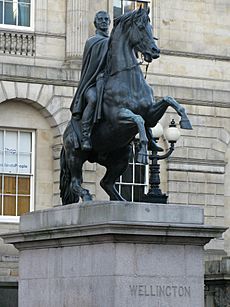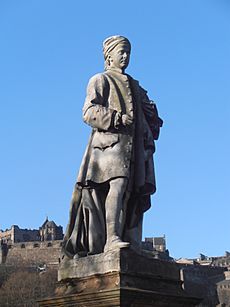John Steell facts for kids


Sir John Robert Steell (born September 18, 1804, in Aberdeen – died September 15, 1891) was a famous Scottish sculptor. He created many statues of important people from Scottish history and culture. You can see many of his best-known sculptures in Edinburgh, like the statue of Sir Walter Scott at the bottom of the Scott Monument. He was also a member of the Royal Scottish Academy.
Contents
About John Steell's Life
Steell was born in Aberdeen, Scotland. When he was two years old, his family moved to Calton Hill in Edinburgh. He was one of many children in his family. His father, John Steell senior, was also a carver and gilder. Because his father was well-known, John Steell was often called "John Steell Junior" early in his career.
John Steell first followed in his father's footsteps, training to be a carver. In 1819, his father faced financial difficulties. However, young John showed great artistic talent. So, his family sent him to study art at the Trustees Academy in Edinburgh.
Working with his father, Steell got his first big job in 1827. A company in Edinburgh asked him to create a large wooden statue of St Andrew. This statue was placed outside their office. It was noticed by many artists in Edinburgh, who praised it as a fine piece of art. Because of this success, Steell traveled to Rome in 1829 to study sculpture even more.
His first work to gain international attention was Alexander taming Bucephalus. He carved this statue between 1832 and 1833. Later, it was cast in bronze in 1883. Today, you can see it in the courtyard of Edinburgh City Chambers. Around 1838, he became the official sculptor for the Queen in Scotland. In 1840, he opened Scotland's first special workshop for casting sculptures in bronze.
Steell became very famous, even receiving requests for sculptures from countries like the United States, Canada, and New Zealand. In 1876, he was knighted by Queen Victoria. This happened after she unveiled his statue of The Prince Consort in Charlotte Square in Edinburgh.
Sir John Steell passed away at his home in Edinburgh on September 15, 1891. He is buried in an unmarked grave in Edinburgh's Old Calton Burial Ground.
John Steell's Family
In 1826, John Steell married Elizabeth Graham.
His youngest son, Graham Steell, became a well-known doctor and heart specialist. He is famous for discovering a specific heart sound that is named after him.
Sir John Steell's brother, Gourlay Steell, was also a famous artist. He was known for painting animals. He even became Queen Victoria's animal painter after Sir Edwin Landseer. Many of Gourlay Steell's paintings are still owned by the Royal Family today.
Famous Sculptures by John Steell
Sir John Steell created many important sculptures. Here are some of his notable works:
- A wooden statue of St Andrew (1827). This statue is now in Dalkeith.
- A stone statue of St Andrew, similar to the wooden one, now at the Wardlaw Museum in St Andrews.
- A wooden statue of a Moor smoking a pipe (1835), which is now in the National Museum of Scotland.
- The famous statue of Sir Walter Scott sitting with his dog Maida (1840–46). This statue is at the base of the Scott Monument in Edinburgh. It was carved from a single, huge block of marble.
- A stone statue of Queen Victoria on top of the Royal Scottish Academy building (1844) in Edinburgh.
- A statue of artist Allan Ramsay (1850) in Edinburgh.
- A large bronze statue of the Duke of Wellington on horseback (1852) outside Register House in Edinburgh. People called it "the Iron Duke in bronze by Steell."
- A statue of Professor John Wilson (1856) in Princes Street Gardens, Edinburgh.
- A statue of Lord Melville (1857) in the center of Melville Street in Edinburgh.
- A bronze statue of Florence Nightingale (1862), which you can see at the Derby Museum and Art Gallery.
- A statue of James Wilson (1863), who founded The Economist magazine, in Hawick.
- A seated statue of Scottish poet Robert Burns (1871) in Central Park, New York City.
- A statue of Prince Albert (1876) in Charlotte Square in Edinburgh.
- A statue of Dr. Thomas Chalmers (1878) in George Street, Edinburgh.
- Another seated statue of Sir Walter Scott (1880) in Central Park, New York City.
- Statues of Robert Burns in Dundee (1880), London (1884), and Dunedin, New Zealand (1887).
- A bust of Robert Burns (1885) in Westminster Abbey.
- The statue Alexander taming Bucephalus in the courtyard of Edinburgh City Chambers.
Gallery
-
Statue of Sir Walter Scott at the Scott Monument in Edinburgh
-
Pediment of the Bank of Montreal Head Office, Montreal
-
The Iron Duke in bronze by Steell, Edinburgh, with Balmoral Hotel in background
-
The Iron Duke in bronze by Steell, Edinburgh
-
93rd Sutherland Highlanders memorial, Glasgow Cathedral
-
Alexander taming Bucephalus in Edinburgh
-
Statue of Robert Burns in The Octagon, Dunedin, New Zealand
-
Statue of Sir Walter Scott in Central Park, New York City
See also
 In Spanish: John Steell para niños
In Spanish: John Steell para niños












